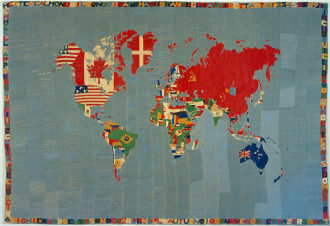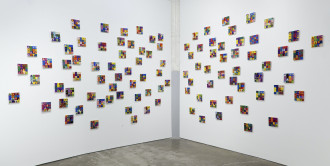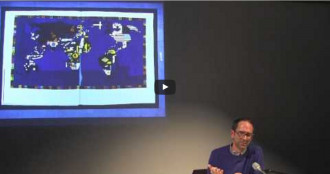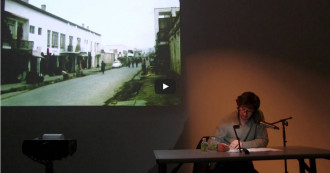Alighiero e Boetti
May 18, 2013–February 17, 2014, Dia Beacon
Overview
This presentation of embroideries and works on paper from Dia’s collection captures the playful tenor of Alighiero e Boetti’s later work. Among the highlights is the monumental Untitled—Victoria Boogie Woogie (1972), composed of 5,040 envelopes the artist mailed to himself in Turin from cities throughout Italy.
In 1968, Alighiero Boetti inserted the conjunction "e" ("and" in Italian) between his first and last names, doubling his identity into a conceptual duo known from then on as "Alighiero e Boetti." This gesture introduced the principles of duplication and multiplication that would be manifest in nearly all of his works thereafter, in a perpetual "quest of happy coincidences."1
Boetti’s appetite for serendipity led him to leave Italy and travel to Afghanistan in 1971 at the age of thirty. It was during this initial month-long stay that he first commissioned Afghan craftswomen at an embroidery school to make tapestry-woven kilims, and conceived of his most extensive serial work, Mappa del Mondo(Map of the World). The embroideries, which varied in style, scale, and background colors, were based on an academic atlas that he altered by hand, coloring the geographic areas of each country with their national flags, merging formal coincidences with political alliances. In addition to the atlas, Boetti also provided sentences for the artisans to transcribe around the margins, each letter placed inside a single square.
In the case of Mappa (Map) (1972), the text on the upper border reads "METTERE AL MONDO IL MONDO" ("Bringing the World into the World"). Across the bottom edge, the inscription functions as a legend to the sewn image—"Alighiero e Boetti are in Kabul in autumn 1000 nine 100 seventy 2 three four"—while the letters on the left edge list the phonetic spelling, in Italian, of the first ten letters of the alphabet, playfully emphasizing the plural tense of his new identity.
The selection and execution of border inscriptions for each Mappa also estab-lished Boetti’s consideration that language could visually function on its own. He created a second group of text-based embroideries known asArazzi (Tapestries) or Quadratini (Small Squares), which depict sixteen-letter sentences drawn from puns and phrases and arranged into a square. Boetti termed this process "squaring language." In the embroidery Ammazzare il tempo(To Kill Time) (1978), he placed the words to be read from top to bottom, totaling a hundred variations of the popular expression for coping with boredom. The theme of time, a prevalent motif in Boetti’s repertoire, is deliberately objectified in the manual realization of each tapestry, a production that required multiple embroiderers and took up to two years to complete.
By the time Boetti was invited to have his first one-person exhibition in New York City at John Weber Gallery, he had carried out an epic action on an unprecedented scale that involved the circulation of 5,040 envelopes through the Italian postal service. Similarly to Mappa, Untitled–Victoria Boogie Woogie (1972) expands on the idea of charting geographies and Boetti’s fascination with classifications, in this instance through a topographic picture plane of traces and evidence from the commute traversed by each envelope. The envelopes, which he addressed to himself over a period of two years from various cities in Italy, required purchasing a total of 35,280 postage stamps. Using the standard postage, Boetti selected seven different colors and values that, combined, added up to 200 Italian lire, the cost of mailing a letter in the mainland. In total, he achieved 5,040 different combinations without a single repetition. Framed in 42 groups of 120 each, the envelopes created a grid of horizontal and rectilinear sequences, illuminating the title’s reference to Piet Mondrian’s Victory Boogie Woogie (1942–44).
This strategy of formulating a game of logic and randomness was further developed in Opera Postale(Postal Work) (1980), a series of 205 works on paper displayed alongside the envelopes used for their postage from Rome to Tokyo (March 11–May 21, 1980). Addressed to Akao Art Agency, the gallery where the artist was scheduled to have an exhibition that summer, the number of stamps used followed a simple mathematical sequence, increasing in each grouping to add the total value of 1,000 lire. Once again, the act of sending a letter becomes a study of numerical progressions and multiplications as they display in time and travel. While the envelopes convey a laborious, programmatic process, each of the accompanying works on paper playfully capture the artist’s surroundings, pairing the complex structure of order and the happenstance nature of disorder.
1. Bonito Oliva, Achille, "Interview with Alighiero Boetti–Milan, 1973" in When 1 is 2: The Art of Alighiero e Boetti, ed. by Paola Morsiani (Houston: Contemporary Art Museum, 2002): 93
Artist
Alighiero e Boetti
(1940–1994)
Alighiero e Boetti was born in Turin, Italy, in 1940. He died in Rome in 1994.
Art

Alighiero e Boetti
Mappa, 1972
Go to Mappa page
Alighiero e Boetti
Opera Postale, 1980
Go to Opera Postale page
Alighiero e Boetti
Ammazzare il tempo, 1978
Go to Ammazzare il tempo page
Alighiero e Boetti
Untitled - Victoria Boogie Woogie, 1972
Go to Untitled - Victoria Boogie Woogie page
Alighiero e Boetti
Untitled (January–December), 1986
Go to Untitled (January–December) pageBooks
Worlds Envisioned: Alighiero e Boetti and Frédéric Bruly Bouabré
This catalogue for the exhibition Worlds Envisioned brings into dialogue the works of the Italian artist Alighiero e Boetti and Ivoirian artist/author Frédéric Bruly Bouabré, who share a fascination with taxonomy and the inversion of epistemological conventions.
Explore
Jonathan Monk on Alighiero e Boetti
Move to Jonathan Monk on Alighiero e Boetti pageMario Garcia Torres on Alighiero e Boetti
Move to Mario Garcia Torres on Alighiero e Boetti page
Jonathan Monk on Alighiero e Boetti
Move to Jonathan Monk on Alighiero e Boetti page

